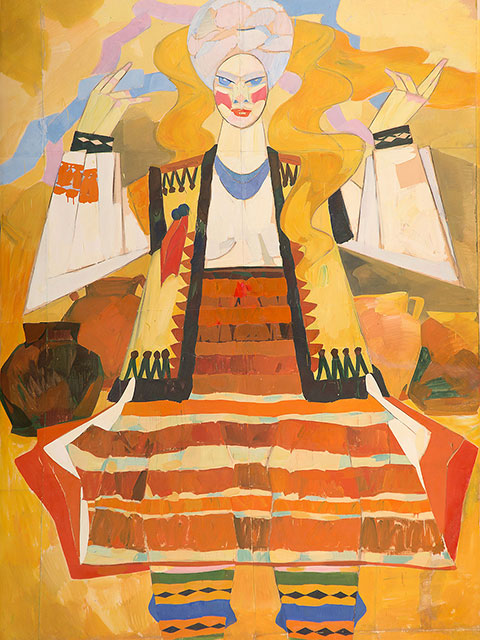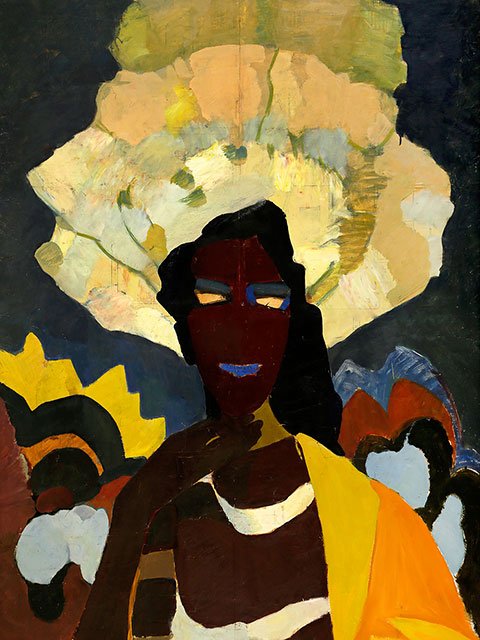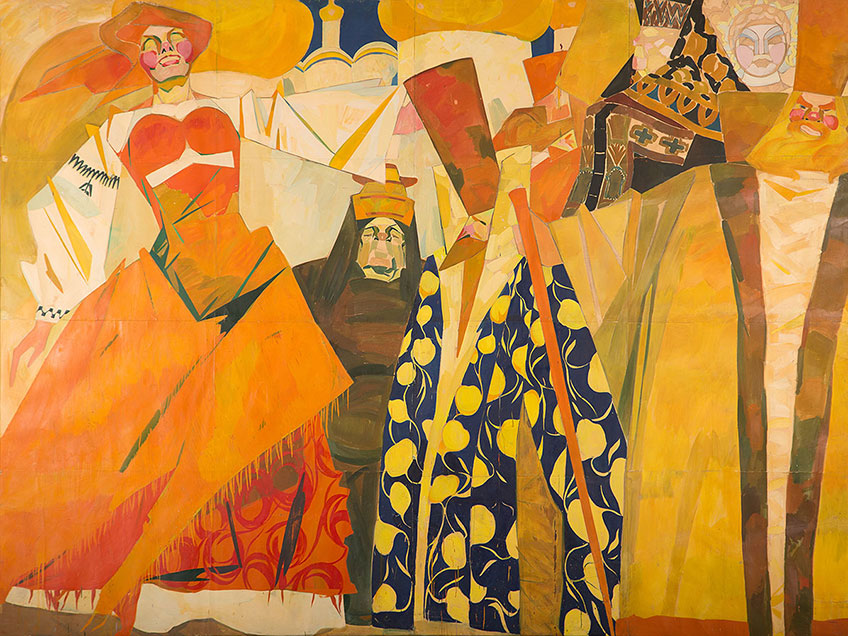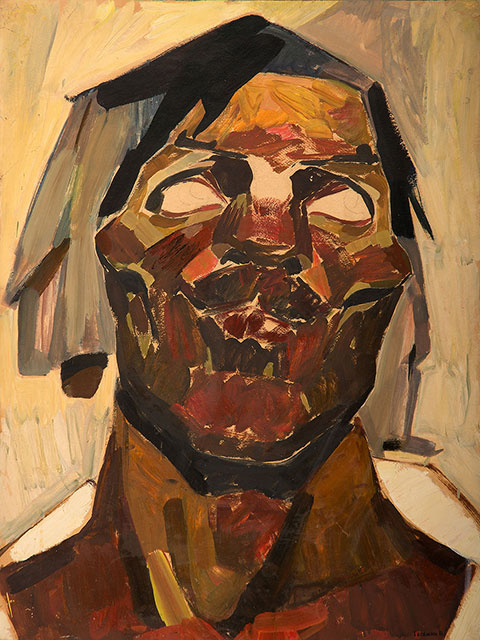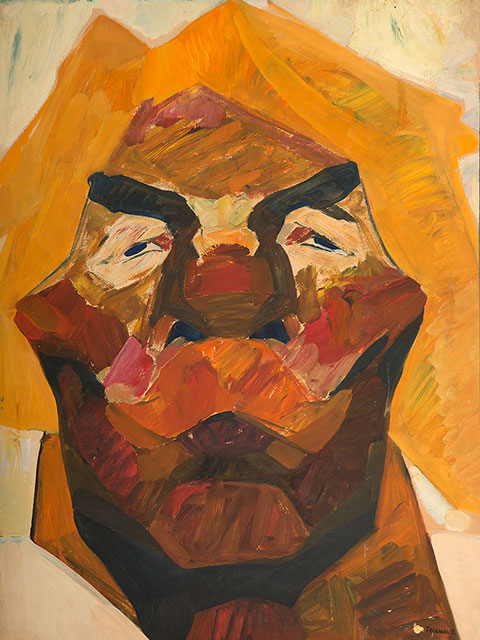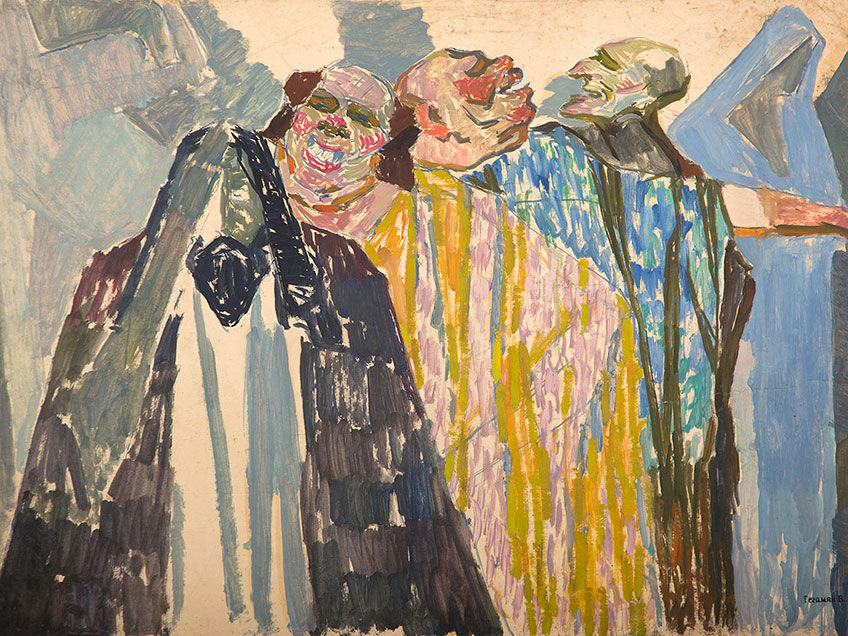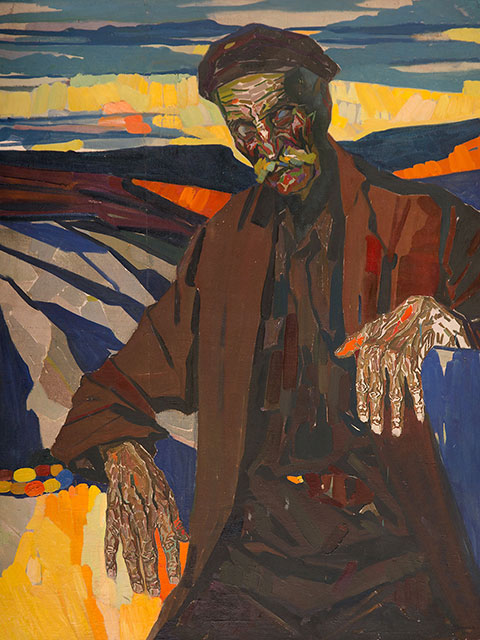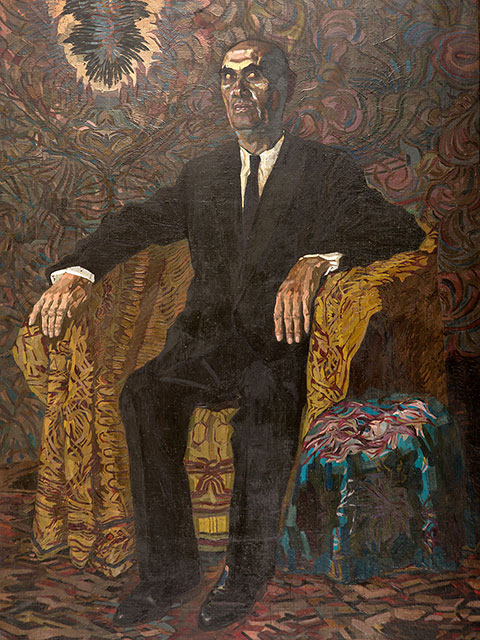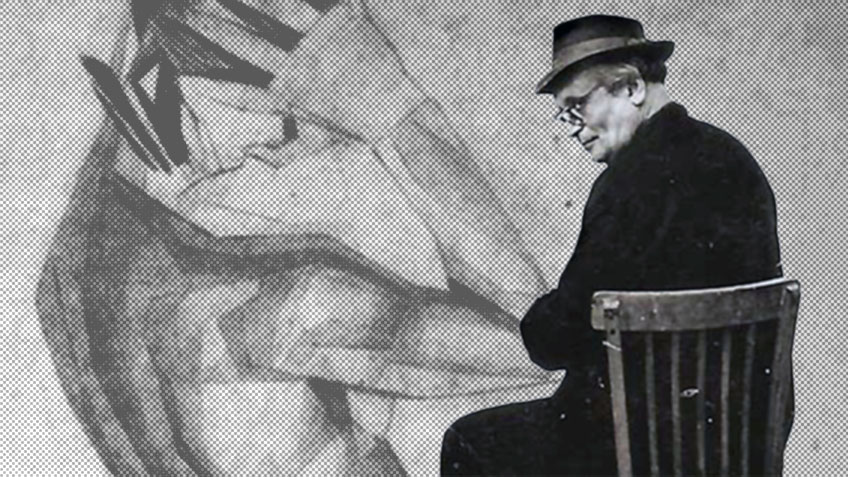
The personality of Valery Geghamyan in the Odessa artistic environment
Valery Arutyunovich Geghamyan (1925–2000) realized more as an extraordinary teacher in his life. Only after his death the recognition of his easily recognizable graphics and incredibly emotional painting came. The artist practically did not exhibit his works at art exhibitions, was not a member of the Artists' Union and did not have any regalia. The fact that he is a brilliant draftsman and painter was known to a relatively small circle of people associated with the art and graphic faculty of the Odessa Pedagogical Institute and members of his family.
Valery (Valik) Geghamyan was born in 1925 in Garna in the family of Harutyun Khanagyan, a famous comedian who worked in the theaters of Yerevan. The mother of the future artist came from the ancient Armenian princely family Ter-Melik Sitian. Valery's father was soon repressed, his real name became dangerous, and the family was able to officially give the boy a fictitious surname formed on behalf of his grandfather, Geghama. That's how Valery Geghamyan appeared.
The artist's childhood and youth were spent among the Armenian intellectual and cultural elite. The family was on friendly terms, in particular, with the composer Aram Khachaturian, who noted Valery’s musical abilities. It should be noted that the young man was seriously playing the saga and thinking about a musical career. According to members of the artist's family, Valery also tried his hand at fiction. During his school years he wrote knightly stories and illustrated them himself. Thanks to these illustrations another regular of the Ter-Melik Sitian family, Martiros Saryan, a world-famous painter with a solid creative biography at the time, drew his attention and contributed to his further artistic development. In 1921, M. Saryan and his family settled in Yerevan and initiated the creation of new cultural institutions: the Association of Artists, the Society for the National Monuments Protection, the Art School, the Museum of Archeology, Ethnography and Fine Arts.
Thanks to his abilities Valery entered the Yerevan Art School, where he studied under the guidance of Martiros Saryan. After graduation he continued his professional education at the newly opened Yerevan Art Institute, again in the Martiros Saryan’s studio. The relationship between Valery Geghamyan and Martiros Saryan went beyond the relationship between the student and the teacher, they communicated closely and outside the classroom. On his way to the plein airs in Garni, Saryan stayed at the house of the Ter-Melik Sitian family. Valeriy was also on friendly terms with Saryan's eldest son, Sarkis. Sarkis Saryan was several years older than Valeriy and was already studying at the university. In the future he will make a brilliant scientific career in the field of literary studies. While attending university classes "for company" with Sarkis, Valery received knowledge in philosophy, history, archeology, and literature as a teenager. He was lucky enough to listen to lectures by academicians J. Orbeli, A. Isaakyan, and others. Thus, the education of Valery Geghamyan had a multifaceted orientation and was not limited to the classical set of artistic theories and practices. He was an excellent operator of historical facts, well versed in philosophy and deeply knew the history of all arts. The Saryan’s influence on the formation of artistic thinking and Geghamyan’s creative manner is difficult to overestimate [3, p.6]. For all the formal differences between the arts of these two artists, it is impossible not to mention the Saryan origin of color in the Geghamyan’s works.
After successful Art Institute graduation the young artist who at that time had already taken part in several art exhibitions, worked for a year at the Art Foundation of Armenia as a senior master and was preparing to join the Union of Artists. At the same time, in 1951, he was accepted as a candidate for membership in the Union, but because he did not submit the necessary documents in time (this is how the official wording sounded), namely photos of works, his candidacy was not approved in Moscow, although he learned about this many years later.
At the beginning of 1954 the artist moved to Moscow. He got a job as a senior master and later a monumental artist at the Combine of Decorative and Applied Arts. This is a good start for any young artist, but the two years that Geghamyan spent in the capital passed unnoticed by his work. High competition from colleagues, constant intrigue for the order took away too much time and energy. And, in general, the situation of constant struggle for survival in Moscow artistic environment exhausted the artist. One of the unexplained facts in the Valery Geghamyan’s biography is still the reason for the communication termination with Martiros Saryan. Perhaps further research into the archives of Valery Geghamyan and Martiros Saryan will help shed light on this issue.
Valery Geghamyan left Moscow for Birobidzhan by the assignment of the Ministry of Education, then for Makhachkala. He devoted six years to organizational and teaching activities in art schools of these cities while working on large paintings. These works are done with oil on canvas in contrast to later works done on cardboard.
Probably the relationship at the last place of work did not develop. Interestingly, a document has been preserved in the personal archive of the artist which testifies to the artist's intentions in 1961 to move to Berdychiv and teach at the local pedagogical institute.
The beginning of the sixties is marked in the national history as a short period of limited, yet freedom. Coincidentally the beginning of the sixties for Geghamyan is the beginning of his own new history. It was at this time that he met his future wife Boleslava Mykhailovska and, on her initiative, moved to Odessa forever.
It was not easy to get a professional job in Odessa. He temporarily worked in the painting shop of the Odessa regional branch of the Art Fund of the USSR, but was fired a few months later due to lack of orders. He was then enrolled in the Designers' Shop and fired again a few months later for the same reason. Only in the summer of 1964 Valery Geghamyan got a permanent job – a teacher of drawing at the Odessa Pedagogical Institute named after K.D. Ushinsky (now South Ukrainian State Pedagogical University named after K.D. Ushinsky)
It is thanks to the initiative and efforts of the artist that the art and graphic faculty was organized in this educational institution. Valery Geghamyan worked there as a senior lecturer, served as a dean for several years, held the position of associate professor, developed curricula and for many years was the head of the methodical commission of the faculty. His pedagogical activity is of great interest, because the artist did not just copy the instructions and methods of other educational institutions, especially Leningrad, where he personally traveled for teaching materials.
Valery Geghamyan consistently developed the author's teaching methodology, which had clear principles. He is the author of curricula for the preparatory department of the faculty, a three-year curriculum for teaching drawing, painting, composition and plastic anatomy. Based on these developments in the seventies, the teacher concluded detailed work plans for the preparation and conduct of the educational process for the fourth course, in which he provided not only the gradual development of tasks, but also their consistency with the teaching of related disciplines: relevant sections of art history, anatomy, perspectives, literature. These curricula were supported by a strong source base and had practical recommendations for homework.
The methodical manual on work on the painting diploma project, concluded in the same period, contained unique tables with the detailed description of the basic stages of work on the sketch and was supplemented with a large amount of illustrative material. On separate sheets Valery Arutyunovich personally depicted certain stages of student work. Valery Arutyunovych created similar sheets-illustrations on step-by-step drawing of naked model for the fourth course.
It should be noted that in the artist educational and methodological developments special attention was paid to the drawing of the human figure from nature. He advised the students to imitate P. Chistyakov, "a true teacher of the inviolable laws of form" (in the words of Valentin Serov) and to study anatomy carefully and deeply. Like Pavel Chistyakov, Valery Geghamyan tried to teach his students how important it is in art to know its laws that the basis of fine arts is drawing. Essentially, Valery Geghamyan’s pedagogical system is neo-academic, with an obligatory emphasis on drawing nature, colossal time costs and an exceptionally perfectionist approach. "Geghamyan's school evokes associations with Filonov's school in me. Not on formal grounds, but because of a bizarre combination of innovation and dogmatism" – ruminates one of the most successful students of Valery Gegamyan, Alexander Roitburd [18].
Drawing and painting as analysis and only later composition as synthesis had a logical conclusion in creating a thematic picture. The highest interest to the nature, especially human, is distinguished by the creative work of Valery Geghamyan. Back in the mid-forties he wrote in his youth diary detailed descriptions of complex emotional states of man and their physiognomic expression [3, p.4-5]. Over time, the artist will not lose interest in nature, but will shift the emphasis: he will be interested in the generalized image, rather than individual manifestations of human nature. Deliberate emphasis on the general as opposed to the individualized will allow the artist to create the best examples of thematic paintings on comprehensive universal themes.
The teacher worked next to the students every day. His teaching methods were based on personal example, not on abstract theorizing "as it should be." He was constantly in the studio and drew the same settings as his students. According to students, Valery Geghamyan rarely criticized student mistakes. And in general he was concise and tolerant in his assessments of other people's work [19]. However, this did not prevent him from being strict and demanding when it came to daily drawing exercises.
The main shortcomings of young artists, including many "stars" of both official and underground art, the teacher considered their lack of academic education, sketchiness and unfoundedness of most works. He despised official Odessa art for its low level of skill and false ideological servility, and did not communicate with nonconformists, considering their experiments frivolous and not perceiving their bohemianism. He modeled artists of past epochs Michelangelo, P. Gauguin, M. Vrubel, I. Repin, M. Saryan, K. Korovin, V. Serov, P. Kuznetsov, M. Nesterov, A. Arkhipov, O. Golovin, P. Korin, O. Murashko, N. Altman, M. Avetisyan.
It is worth noting that Valery Geghamyan paid a lot of attention to the famous masters’ painting and drawing studios. It is difficult to call these works as copies, rather they are the author's rethinking of the ideas of the classics. Geghamyan thus "studied" Michelangelo, I. Repin, M. Vrubel, K. Bryulov, M. Saryan, V. Serov, O. Ivanov, K. Petrov-Vodkin, and others.
The artist's archive contains references to his trips with students to plein airs in the Crimea and the Carpathians, during which he, as well as in the auditorium, continued to work alongside students. Valentin Zakharchenko recalled that he saw Geghamyan working in the plein air, how he was interested in what he saw. And that this is a normal move of a mature artist – when he does not yet know what he wants, but already feels somewhere. Nature suggested intuition and he shaped this vision into the end result [7]. The teacher's example became a motivation for young artists and the general culture and dedicated service to art inspired respect.
The dry analytical system of drawing developed by V. Geghamyan required from students complete explosion and full dedication. It was so fascinated by young artists that some of them had to "leave” it for several years after graduation to find their own style. However, the best description of the artist's pedagogical activity was the comments of colleagues that Geghamyan's students were immediately visible. It was an exceptionally meticulous and mathematically calculated drawing. The strong rational component of Geghamyan's drawing in pencil or charcoal outweighed the emotional component, but his painting is balanced. "Geghamyan's system is the higher mathematics of plastics, it is the metrology of color spot parameters, it is the syntax of anatomy, it is the prediction of computer 3D modeling algorithms and finally, it is a religious doctrine" - so one of the students defined the essence of his method [18].
According to Vasyl Ryabchenko, there is no equal for such a painter as Valery Geghamyan today. "I remember he came, glued a strip of wallpaper - three meters high, one and a half wide. And drew. And it was just brilliant."[19]
For twenty years of work at the Faculty of Graphic Arts Valery Arutyunovich brought up a lot of famous students, among them there are the realized artists Valentin Zakharchenko, Eugene Rachmanin, Vasily Ryabchenko, Alexander Roitburd, Victor Volkov, Oleg Nedoshitko, Sergei Lykov, Ivan Dimov, Vitaly Onishchenko, Oksana and Anatoliy Furlets, Yuri Gorbachev, Viktor Pokydanets, Grigory Sultan and others [6, p.60]. Some of his students are also engaged in pedagogical activities, using the experience of their teacher.
After retiring in 1985 Valery Geghamyan focused entirely on creativity. He leads an extremely closed lifestyle, almost ceases to be in contact with the outside world, maintains superficial relationships with a very limited number of people. At this time he created his most famous monumental works "Khachkar" and "Wedding without love", sometimes working 16 hours a day. If before he selflessly gave himself to teaching, now he selflessly makes up for everything he did not have time to do in art.
The artist died in September 2000 and was buried in Odessa.
Valery Geghamyan's activity is difficult to squeeze into the framework of traditional ideas about the work of a teacher and an artist. He was too talented and subtle for a teacher. For an artist he was too rational and purposeful. He completely ignored the exhibition activity, did not fulfill any orders of works of art. Instead, he devoted the last fifteen years of his life to the fanatical realization of his ideas, searching for new means of expression.
The personality of Valery Geghamyan – an artist with a recognizable author's handwriting – played a key role in shaping the Odessa artistic environment of the second half of the XX century. The artist became the founder of the graphic faculty at the Odessa Pedagogical Institute and brought up several generations of original artists. The complex author's methods developed by V. Geghamyan have the basis of classical art education, but are successfully adapted to the requirements of modernity and contain the most characteristic features of the individual figurative and technical manner of the master. Valery Geghamyan's work and teaching are openly synthetic. Both types of his professional activity are based on classical traditions, but in the end they are qualitatively new phenomena. The obtained scientific results allow for further in-depth differentiation of research on this issue. The following art exploration will be devoted to the analysis of Valery Geghamyan's pictorial and graphic heritage, as there is a need to introduce information about the master's works into scientific circulation.
